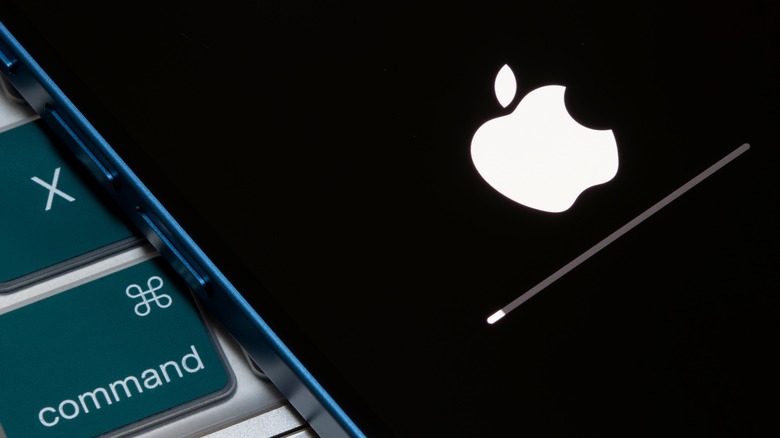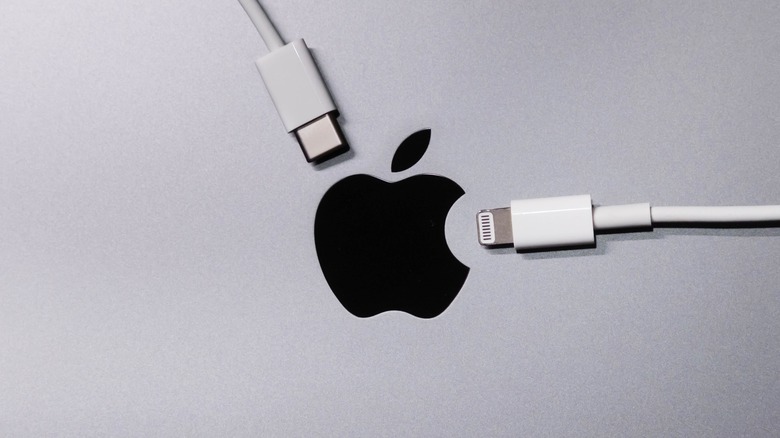Here's What It Means If Your iPhone Is Stuck On The Apple Logo
Like pretty much all forms of modern technology that relies on some form of computing, iPhones can and do lock up from time to time. Also like most modern devices, there are several kinds of hardware freezing you may encounter — it depends on what the problem is. However, your iPhone sticking on the Apple logo isn't quite the same as a mid-action freeze (i.e., whatever app or feature you're using causes the iPhone to stop responding to taps and hang on a static screen).
You're most likely to see the white Apple logo on a black screen when your iPhone is restarting or installing a new update, and if it doesn't go away, there is probably an issue with that process. In most cases, you can get around the frozen logo by restarting your iPhone and then re-attempting the update installation or data transfer in the hopes that whatever hiccup caused it the first time won't happen again. That said, this frustrating problem can sometimes be an indicator of bigger (hardware-related) issues. So if you attempt all of the methods below and your iPhone still won't load past the startup screen, be prepared to reach out to Apple for help.
Dealing with a stuck iPhone
Unless your iPhone (or the progress bar) has been stuck for more than an hour, consider waiting a little longer as you may just be dealing with a delay rather than freezing. Otherwise:
- Try a forced restart on an iPhone 6S and older by pressing and holding the Home and Power buttons at the same time until the iPhone restarts. On an iPhone 7, press and hold the Power and Volume Down buttons instead.
- On an iPhone 8 or newer, press (but don't hold) the Volume Up button, then immediately do the same with the Volume Down button, and then press and hold the Power button until the iPhone restarts (and ignore the shutdown slider if it appears).
- If a forced restart doesn't work, restart in Recovery Mode instead by connecting your device to a computer, then selecting your iPhone on the computer via the Finder (macOS 10.15 Catalina and later) or through iTunes (macOS Mojave 10.14 and older, Windows).
- While the iPhone is still connected to your computer, follow the same steps to force restart as above (based on the phone model) and wait for the Recovery Mode screen to appear on your iPhone's screen.
- When the Update or Restore pop-up appears on your computer screen, select Update. Repeat the process if the update takes longer than 15 minutes and your phone exits Recovery Mode.
If you're still seeing the logo, there are a couple more extreme options you can try.
Other possibilities
If the logo freeze is happening when your iPhone is connected to another device, your cable might be the real problem. Switch it out to see if that makes a difference. If not, a final resort is the Device Firmware Update (DFU) restore:
- Connect your iPhone to a computer and select it from the desktop — Finder in macOS 10.15 and newer, iTunes in macOS 10.14 and older and on Windows.
- For an iPhone 6S and older, press and hold the Power and Home buttons for 10 seconds, then release the Power button but keep holding Home for another five seconds.
- For an iPhone 7, press and hold Power and Volume Down for 10 seconds, then release Power but keep holding Volume Down for five more seconds.
- On the iPhone 8 and newer, press and release Volume Up and quickly do the same for Volume Down, then press and hold the Power button until the screen turns black.
- Keep holding Power but also push and hold Volume Down for five seconds, then release Power but keep holding Volume Down.
- The screen should remain black. If the Apple logo appears, you've entered Recovery Mode and will need to try again.
- Wait for the iPhone detection pop-up on your computer, then click Restore.
Be aware that a DFU restore will delete all of the data stored on your phone — and if your phone is damaged (broken screen, malfunctioning ports, etc.) you may never be able to exit DFU mode. If that sounds scary, consider taking your phone to an Apple Store for help instead.


